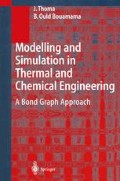Abstract
The first problem for a control or systems engineer in front of a process to control is to obtain a precise and easily manipulated model with predictions corresponding to the real observation. The different mathematical equations describing a system and to predict its behaviour is called a mathematical model. The mathematical model can also be defined as an operator giving the relation between input and output signals. It is important to note that input and output variables refer to the model and not to the physical system: for instance the steam flow out of a boiler can well represent the input of a model.
Access this chapter
Tax calculation will be finalised at checkout
Purchases are for personal use only
Preview
Unable to display preview. Download preview PDF.
References
Borne P. et al. “Modélisation et identification des processus”, Tome 2. Edition Technip, Paris, 1992.
Callendar, H. L., “Presidential Adress”, Proc. Phys. Soc, pp. 153–189, London 1911.
Carnot, S. 1824, “La puissance motrice du feu”. Original in french, english edition by E. Mendoza, Dover Publications 1960.
Falk, G, “Energie und Entropie”, Springer Verlag
Fuchs, H. U., 1996, “The Dynamics of Heat”, Springer Verlag, 1996.
Karnopp D. C. and R.C. Rosenberg “Systems dynamics. A unified Approach”, Wileey Intersciences; New York, 1975.
Karnopp, D. C., “State Variables and Pseudo-Bond graphs for Compressible Thermofluid Systems”, Trans. ASME J. DSMC, Vol. 101, p. 201–204, 1979.
Karnopp D. C. and R.C. Rosenberg “Systems dynamics. A unified Approach”, Second edition Wileey Inter-sciences; New York, 1990.
Lorenz, F. “Modelling level, a question of semantics”, IMACS ESIEE CESA’96 Multiconference, Lille, France, 1996.
Sueur, C., Dauphin-Tanguy “Bond-graph approch for structural analysis of MIMO linear system”, J. of the Franklin Institute, 328, N°. 1, pp. 555–70, 1991.
Tagina, M., “Application de la modélisation bond graph à la surveillance des systèmes complexes”, Ph.D Thesis, University of Lille, octobre 1995.
Thoma, J. U., “Modern Oilhydraulic Enginnering”, Trade and Technical Press Ldt, Morden, Surrey, England, 1971.
Thoma, J. U, “Simulation by Bond graphs”, Springer Verlag 1991.
Author information
Authors and Affiliations
Rights and permissions
Copyright information
© 2000 Springer-Verlag Berlin Heidelberg
About this chapter
Cite this chapter
Thoma, J., Bouamama, B.O. (2000). Introduction to Thermodynamic Systems Modelling. In: Modelling and Simulation in Thermal and Chemical Engineering. Springer, Berlin, Heidelberg. https://doi.org/10.1007/978-3-662-04181-9_1
Download citation
DOI: https://doi.org/10.1007/978-3-662-04181-9_1
Publisher Name: Springer, Berlin, Heidelberg
Print ISBN: 978-3-642-08566-6
Online ISBN: 978-3-662-04181-9
eBook Packages: Springer Book Archive

